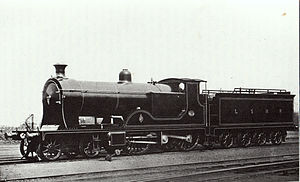LSWR T7 class
This article needs additional citations for verification. (December 2015) |
| LSWR/SR T7 [1] and E10 | |||||||||||||||||||||||||||||||
|---|---|---|---|---|---|---|---|---|---|---|---|---|---|---|---|---|---|---|---|---|---|---|---|---|---|---|---|---|---|---|---|
 LSWR T7 4-2-2-0 | |||||||||||||||||||||||||||||||
| |||||||||||||||||||||||||||||||
| |||||||||||||||||||||||||||||||
| |||||||||||||||||||||||||||||||
| |||||||||||||||||||||||||||||||
The LSWR Class T7 4-2-2-0 was a prototype express steam locomotive design by Dugald Drummond for the London and South Western Railway introduced in 1897. Five similar locomotives, classified E10, were introduced in 1901.[2]
Background
Number 720 was a prototype locomotive built in 1897 and classified T7. The layout was unusual and influenced by Francis Webb's 3-cylinder compound locomotives introduced in 1883 on the London and North Western Railway (LNWR) that employed two pairs of uncoupled driving wheels; the Drummond locomotives were always known as the "double singles". Five similar locomotives, numbers 369-373, were built in 1901 and classified E10.
Design features
Throughout locomotive history, this type of layout with independent uncoupled trains of driving wheels mounted on a common rigid chassis has been repeatedly tried with various aims in mind (the best-known more recent example is the Duplex locomotive).
Aims
In the case of Drummond, the main motive appears to have been to obtain maximum grate area in a period where low-pitched boilers were the norm and the firebox had to be set low between the frames. This limited the width of the grate whilst its length depended on the distance between the coupled axles minus the throw of eventual inside cranks; at the same time there was a reluctance to make the coupling rods too long due to concerns about material resistance, for a broken coupling rod could impact the locomotive or anything by the track. One way to resolve this was to eliminate the coupling rods and to have two independent pairs of driving wheels each pair driven by its own cylinders.
Earlier experiments
The first engineer known to have adopted this solution was Francis Webb, followed by Alfred de Glehn in France who initially combined divided drive and independent driving axles, finally opting solely for the former whilst coupling the driving wheels. The aforementioned engineers' locomotives were compounds, and the layout was also a way of separating high-pressure from low-pressure drive trains.
Drummond's locomotives
- Boiler
Drummond's T7 and E10 worked with simple expansion so that the principal benefit sought would be the increased grate area. Compared with Drummond's standard boilers, the T7's barrel length was increased by 1 ft 6 in (0.46 m) to 12 ft (3.7 m).
- Valve gear
Another unusual feature of the T7 and E10 locomotives was the valve gear. The valves for the inside cylinders were operated by Stephenson valve gear and the valves for the outside cylinders were operated by Joy valve gear.
Rebuild
In 1905, number 720 was rebuilt with a larger boiler with the diameter increased by 5.25 in (0.133 m) to 4 ft 10.75 in (1.4923 m). The E10s were not rebuilt.
Construction history
- T7, 1 locomotive built 1897, number 720
- E10, 5 locomotives built 1901, numbers 369-373
References
- ^ Casserley, H.C. (1971). An illustrated history of LSWR Locomotives. London: Ian Allan. - Enlarged edition of Burtt, F. (1949). LSWR Locomotives - a survey, 1873-1922.
- ^ Casserley, H.C.; Johnston, S.W. (1974). Locomotives at the Grouping 1, Southern Railway. Ian Allan. p. 46. ISBN 0711005524.
- Use dmy dates from May 2017
- Use British English from May 2017
- Articles needing additional references from December 2015
- All articles needing additional references
- London and South Western Railway locomotives
- 4-2-2-0 locomotives
- Railway locomotives introduced in 1897
- Duplex locomotives
- Standard gauge steam locomotives of Great Britain